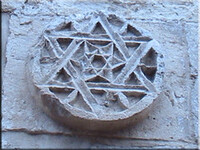Cultural Trauma
This week our studies focused on trauma and cultural trauma. The readings helped us to distinguish between psychological understandings of trauma and socio-cultural understandings of trauma. A cultural theory of trauma emphasizes how collective identities are impacted by significantly disruptive events. We read Richard Sennett's essay on "disturbing memories" which reminded us that "remembering well" includes not just good memories, but bad memories too. Sociologists Eyerman and Alexander helped us to unpack the concept of "cultural trauma" and English professor Marianne Hirsch introduced us to the concept of "postmemory" - traumatic memories experienced in second generations.
La Dictatura
Argentina presently refers to the years from 1974 to 1983 as La Dictatura, meaning the dictatorship. This was one of the most violent and destructive military dictatorships to govern the country. During this period, the President aimed to return to Catholic, Roman, and Hispanic principles and set out to remove anyone who challenged the political or religious systems. Many people were kidnapped in broad daylight and were sent to secret detention centers where they were tortured, stripped of their identities, religion, family, and were completely extracted from society; up to 30,000 people were killed or kidnapped during this time. Among the kidnapped, were pregnant mothers, they were kept until giving birth then killed- the orphaned children were then sent to families who were in support of the government. Las Abuelas de Plaza de Mayo (pictured) fought against the dictatorship for reparation, restitution and reparation through the return and answers regarding their children and their children’s children. They have since uncovered about 500 kidnapped children.
Discussing Cultural Trauma, Alexander emphasizes that “Identity involves a cultural reference…Trauma is not the result of a group experiencing pain. It is the result of this acute discomfort entering into the core of the collectivity's sense of its own identity” (Olick et al, 2011: 306) Eyerman too supports this stating that although there are individual emotional experiences, cultural trauma involves the collective loss of identity. (Olick et al, 2011: 304) Through La Dictatura, the Argentinian people, those disappeared, born in captivity, and their families collectively experienced an immense loss of identity and cultural trauma in that their cultural reference was destroyed through violence, oppression, dehumanization, and appropriation, as well as, their repressed knowledge of the events that took place. (Contributed by CCT)
Cultural Trauma: Changing our Future Identities
In this week's topic on Cultural Trauma, the reading by Eyerman, R (2011), "The Past in the Present: Culture and Transmission of Memory" begs the discussion on what we may think when we hear "Cultural Trauma". This can include many different types of events that have shaped a community’s identification of themselves and their future identity.
This photo represents how people of colour were segregated even from the water fountains of white people. When we think of segregation today, we know that it showed racism in a powerful form. It was also a form of placing power into the hands of white people (patriarchal males) and further shaping the history and identity of people of colour even today.
The readings this week identified how the collective memory is shaped by power and shaped by the experiences and retellings of these experiences into stories passed down through the collective. Today, the identity of people of colour is still heavily influenced by the cultural trauma they were exposed to and changes how. Furthermore, Eyerman states, “…Such narratives form “Master Frames” and are passed on through traditions, in rituals, and ceremonies, public performances, which reconnect a group and where membership is confirmed. Within this process “we” are remembered, and “they” are excluded” (Eyerman, 2011, p.305). - Submitted by SF
"Star of David on the Walls of Jerusalem 1"
Here I have chosen to include an image of the star of David on a wall in Jerusalem. I chose this image because it worked quite well for the Marianne Hirsch essay "The Generation of Postmemory . As an example of cultural trauma Hirsche uses the Jewish people and the Holocaust herself. She describes the kind of trauma that this generation of children of Holocaust survivors experience. The image of the Star of David etched into the walls of Jerusalem. Kind of reflects on the way that the trauma these people live with is permanent and belongs to the Jewish people. The same way that the star is etched into the wall, it is permanently a part of the structure, just as the trauma of the Holocaust is a permanent part of the Jewish people's history. The idea of permanence and post-memory as described by Hirsche in her essay to me are connected as they both describe ways we relate to the past and how that past affects us now. For that reason, I think the image of the Star of David is appropriate as it represents the Jewish people now as well as in the past and reminds us all of the pain and trauma that group of people have endured. - Submitted by IM


